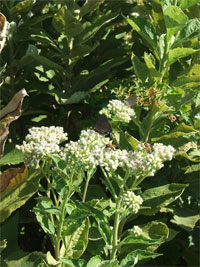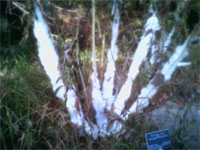Native Son – October, 2007
Photo by: Lisa Adams Grove, Horticulturist, Grapevine Botanic Gardens
I just got back from my second pilgrimage to the Garden Writers Association annual conference … this time in Oklahoma City. (Every self-respecting gardener needs to see the Myriad Botanical Gardens and the amazing Crystal Bridge Tropical Conservatory.) Of course, I took my sweet time coming home down Highway 81 — eyes soaking up the heartland scenery while my mind drifted in and out of reality to Enya’s “The Memory of Trees,” which I let roll over and over on the tape deck. Snapped some happy plant pictures just across the Canadian River in Minco, then got a little bummed out by the sad story told to me by a sad fellow in Chickasha. Kicked those blues by stopping off at a little garden statuary emporium in Marlow, where I filled the truck with stone lanterns, urns, birdbaths, and a four-foot-tall statue of a formally dressed bulldog butler that I decided needed to be named “Nigel.”
The eastern persimmon trees were loaded with amber-colored fruit, and the asters, grasses, and mist flowers tucked here and there along the roadsides were still blooming strong. Just south of Bowie, the LBJ National Grasslands showed the robust glow that only a rainy year can bring. By the time I was heading south on 51 out of Decatur, I began to see glimpses of frostweed in bloom.
Frostweed (Verbesina virginicum) is a tall (6 to 8 feet!), large-leaved, herbaceous perennial that ranges from Texas to the East Coast, usually finding a home at the edges of woodlands, where the prairies and forests meet. While not particularly showy, the cream-colored flowers are simply engorged with high-quality nectar that feeds a myriad of insects, including Mexico-bound migrating Monarch butterflies in the fall. (Many of you have unknowingly seen this plant; it is one of the primary nectar sources for the annual butterfly exhibit at the Texas Discovery Gardens, held annually during the Texas State Fair.) The flowers look a bit like lots of little scrub brushes arranged into larger, fluffy inflorescences. (They might also remind you of the flower structure of their relatives, the mistflowers.) While some populations produce noticeable white petals, the ones I see out in the meadows and remnant prairies around North Central Texas seem to lack them.
Frostweed gets its name from the amazing phenomenon that occurs with the first hard freeze — the thumb-thick main stems of the plant split open and a bizarre, crystallized gel, not unlike Italian ice, is exuded from these wounds. I first encountered this icy froth during a woodland hike back in the winter of 1979, and I distinctly remember being completely amazed and confused by it. It was several years later when I finally found out what was happening, but to this day really don’t know why. (I have spoken to several deer hunters who have also seen this strange spume … one of whom refused to believe it was not frozen deer urine stuck to the stem!)
Though large, frostweed is an effective landscape plant in less formal landscape schemes, particularly butterfly gardens. Because of the timing and nectar quality of the bloom, it should be included in all gardens designed with migrating Monarchs in mind. (It is similar to deciduous hibiscus in both size and texture, so can be used as a substitute for this in background plantings.)
By the time I neared Weatherford, I began to ponder the true beauty of Monarch butterflies … their amazing ability to connect humans with nature, and each other. They cross political boundaries and cultural chasms without hesitation. They connect students from Canada to Kansas to Weslaco to Mexico, creating common ground by flying through the air. They are triggered to migrate by the same sun that triggers the autumn-blooming plants to provide food for their journey. And Monarchs tend to take “the road less traveled” to their destination just so they can visit the best places, people, and plants along the way … just like me.
Visit Steven Chamblee, Chief Horticulturist at Chandor Gardens, 711 West Lee Avenue, Weatherford, Texas. From the Dallas-Fort Worth Metroplex take I-20 (or I-30 – they merge) west to exit 409 (Santa Fe); turn right and go 2.1 miles to Lee Avenue; turn left and go straight 12 blocks and you’re driving in the gates. Call 817-613-1700 or go to www.chandorgardens.com for more information. If you’re visiting during the week, please give the staff a call and let them know you’re coming.



